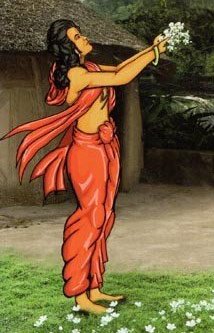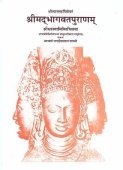Pracetasa, Prācetasa: 12 definitions
Introduction:
Pracetasa means something in Hinduism, Sanskrit. If you want to know the exact meaning, history, etymology or English translation of this term then check out the descriptions on this page. Add your comment or reference to a book if you want to contribute to this summary article.
Alternative spellings of this word include Prachetasa.
In Hinduism
Purana and Itihasa (epic history)
Source: Cologne Digital Sanskrit Dictionaries: The Purana Index1a) Pracetasa (प्रचेतस).—A Prajeśvara.*
- * Brahmāṇḍa-purāṇa III. 1. 54.
1b) (also Praceta)—the collective name of the ten sons of Prācīnabarhiṣa and Sāmudrī; commanded by their father they engaged themselves in penance in the midst of the ocean and meditated on the teachings of Śiva given to them; leaving their home they proceeded to the west and in a park near a great lake heard the divine music; when listening to it, there appeared Śiva who on request initiated them in the meditation on Viṣṇu (Rudragītā); when Śiva left they meditated under the waters for 1000 years. Viṣṇu appeared before them and promised them a son by asking them to marry the daughter of Kaṇḍu and Pramlocā; pleased with seeing the God they praised Him; after his disappearance they came out of the waters and seeing the earth filled with wild growth they began to burn the trees by breathing spiritual fire and wind from their mouth. Brahmā (Soma) interceded then and prevented them from further destroying the trees by offering Vārkṣi (Māriṣā) the daughter of the trees in marriage to them; they married her and she gave birth to Dakṣa on the eve of the Cākṣuṣa epoch.1 After a long period of enjoyment of life they placed their wife under their son Dakṣa and went away to the western sea where Jajali attained siddhi; seeing them steadfast in devotion Nārada came there, and was welcomed by them; requested by them to be instructed to get rid of saṃsāra, Nārada advised them to worship and contemplate on Viṣṇu directly, and than departed; they did so and attained the world of Viṣṇu;2 sacrifice of, when Nārada sang praises of Dhruva;3 worshipped for treasure.4
- 1) Bhāgavata-purāṇa IV. 24 (whole); 25. 1-2; 30 (whole) VI. 4. 4-17; Brahmāṇḍa-purāṇa II. 13. 40; 37. 27; Matsya-purāṇa 4. 47-9; Vāyu-purāṇa 63. 27-9.
- 2) Bhāgavata-purāṇa IV. 31. 1-25.
- 3) Ib. IV. 12. 40; 13. 2.
- 4) Ib. II. 3. 7.
2a) Prācetasa (प्राचेतस).—The sage who revealed the previous birth of king Puṣpavāhana to him.*
- * Matsya-purāṇa 100. 7; Vāyu-purāṇa 62. 72.
2b) (see Pracetasas); the surname of the ten sons of Prācīnabarhis and Śatadrutī; their history; performed tapas as directed by Rudra for 10,000 years. Hari revealed himself before them; entrusting their house to their son, Dakṣa and following Nārada's precepts attained mokṣa; when they rose from the sea they saw the earth covered with trees;1 wife Mārīṣā, the daughter of plants given in marriage by Soma, king of plants, became the mother of Dakṣa.2 Father ordered them to worship Govinda and increase the world's population. The prayer was granted by Govinda. Burnt down trees and uprooted them as they were hindrances to the growth of population.3
- 1) Bhāgavata-purāṇa IV. 24. 13-18; 25. 2; chh. 30 and 31; IX. 23. 15-16. Viṣṇu-purāṇa I. 14. 6.
- 2) Bhāgavata-purāṇa VI. 4. 4-5; Viṣṇu-purāṇa I. 15. 1-10, 71-4.
- 3) Viṣṇu-purāṇa I. 14. 10-48.
Prācetasa (प्राचेतस) refers to the ten sons of Pracīna Varhis and Sāmudrī: the daughter of Sāgara and Velā, according to the Vaṃśa (‘genealogical description’) of the 10th century Saurapurāṇa: one of the various Upapurāṇas depicting Śaivism.—Accordingly, Pitṛ and Svadhā had two daughters—Menā and Dhāriṇi. Dhāriṇi was married to Meru and had a son named Mandara and three daughters—Velā, Niyati and Āyati. Velā was given in marriage to Sāgara and had a daughter named Sāmudrī who married Pracīna Varhis. She gave birth to ten sons who were famous as Prācetasa in Svāyambhuva Manvantara.

The Purana (पुराण, purāṇas) refers to Sanskrit literature preserving ancient India’s vast cultural history, including historical legends, religious ceremonies, various arts and sciences. The eighteen mahapuranas total over 400,000 shlokas (metrical couplets) and date to at least several centuries BCE.
Kavya (poetry)
Source: Shodhganga: The Kavyamimamsa of RajasekharaPrācetasa (प्राचेतस) is the name of an important person (viz., an Ācārya or Kavi) mentioned in Rājaśekhara’s 10th-century Kāvyamīmāṃsā.—It is another name of Rāmāyaṇa’s author Vālmīki. He wrote the Mahākāvya Rāmāyaṇa (Ādikāvya) from the śoka (grief) of a pair of Krañca.

Kavya (काव्य, kavya) refers to Sanskrit poetry, a popular ancient Indian tradition of literature. There have been many Sanskrit poets over the ages, hailing from ancient India and beyond. This topic includes mahakavya, or ‘epic poetry’ and natya, or ‘dramatic poetry’.
Languages of India and abroad
Sanskrit dictionary
Source: DDSA: The practical Sanskrit-English dictionaryPrācetasa (प्राचेतस).—
1) A patronymic of Manu.
2) Of Dakṣa.
3) Of Vālmīki.
Derivable forms: prācetasaḥ (प्राचेतसः).
Source: Cologne Digital Sanskrit Dictionaries: Shabda-Sagara Sanskrit-English DictionaryPrācetasa (प्राचेतस).—m.
(-saḥ) Valmiki, the author of the Ramayana. m. Plu.
(-sāḥ) The ten sons of Prachinavarhi. E. pracetas the father of the poet, and aṇ aff.; it also occurs prācetas m. (-tāḥ) .
Source: Cologne Digital Sanskrit Dictionaries: Benfey Sanskrit-English DictionaryPracetasa (प्रचेतस).—[pracetas + a], see the last.
--- OR ---
Prācetasa (प्राचेतस).—i. e. pracetas + a, patronym. A descendaut of Pracetas, i. e. 1. Vālmīki, [Uttara Rāmacarita, 2. ed. Calc., 1862.] 34, 10. 2. The ten sons of Prācīnavarhis
Source: Cologne Digital Sanskrit Dictionaries: Cappeller Sanskrit-English DictionaryPrācetasa (प्राचेतस).—[masculine] patron. from pracetas.
Source: Cologne Digital Sanskrit Dictionaries: Monier-Williams Sanskrit-English Dictionary1) Pracetasa (प्रचेतस):—[=pra-cetasa] [from pra-cit] mfn.[wrong reading] for prāc
2) Prācetasa (प्राचेतस):—[=prā-cetasa] [from prā] mfn. relating to Varuṇa (= pra-cetas; with āśā f. the west), [Harṣacarita]
3) [v.s. ...] descended from Pracetas (m. [patronymic] of Manu, Dakṣa, and Vālmīki), [Mahābhārata; Harivaṃśa; Purāṇa]
4) [v.s. ...] [plural] = -cetas [plural] [cf. Lexicographers, esp. such as amarasiṃha, halāyudha, hemacandra, etc.]
Source: Cologne Digital Sanskrit Dictionaries: Yates Sanskrit-English DictionaryPrācetasa (प्राचेतस):—(saḥ) 1. m. Vālmīki. plu. The ten sons of Prachīnavahi.
[Sanskrit to German]
Sanskrit, also spelled संस्कृतम् (saṃskṛtam), is an ancient language of India commonly seen as the grandmother of the Indo-European language family (even English!). Closely allied with Prakrit and Pali, Sanskrit is more exhaustive in both grammar and terms and has the most extensive collection of literature in the world, greatly surpassing its sister-languages Greek and Latin.
Kannada-English dictionary
Source: Alar: Kannada-English corpusPracētasa (ಪ್ರಚೇತಸ):—[noun] = ಪ್ರಚೇತ [praceta].
--- OR ---
Prācētasa (ಪ್ರಾಚೇತಸ):—
1) [noun] Vālmīki, the author of the Indian epic Rāmāyaṇa.
2) [noun] (astron.) Śatabhiśe, a bright star in the Southern constellation, Aquarius.
Kannada is a Dravidian language (as opposed to the Indo-European language family) mainly spoken in the southwestern region of India.
See also (Relevant definitions)
Starts with: Pracetasastava.
Full-text (+5): Pracetasastava, Pracetasi, Piracetacan, Pracinabarhisha, Marisha, Durvara, Durvarana, Valmiki, Pracinabarhi, Jajali, Samudri, Dhanurveda, Vela, Brahmadeya, Barhishad, Puṇyajana, Pasha, Daksha, Maharshi, Cakshusha.
Relevant text
Search found 17 books and stories containing Pracetasa, Prācetasa, Pra-cetasa, Prā-cetasa, Pracētasa, Prācētasa; (plurals include: Pracetasas, Prācetasas, cetasas, Pracētasas, Prācētasas). You can also click to the full overview containing English textual excerpts. Below are direct links for the most relevant articles:
Rig Veda (translation and commentary) (by H. H. Wilson)
The Shiva Purana (by J. L. Shastri)
Chapter 30 - Description of Creation < [Section 5 - Umā-Saṃhitā]
Chapter 17 - The Narrative of Creation < [Section 7.1 - Vāyavīya-saṃhitā (1)]
The Vishnu Purana (by Horace Hayman Wilson)
Chapter XIV - Descendants of Prithu < [Book I]
Chapter XV - The world overrun with trees; they are destroyed by the Pracetasas < [Book I]
Corrections < [Preface]
The Bhagavata Purana (by G. V. Tagare)
Chapter 30 - The Marriage of Pracetasas with Māriṣā and the birth of Dakṣa < [Book 4 - Fourth Skandha]
Chapter 31 - The Story of Pracetasas: Their Renunciation and Liberation < [Book 4 - Fourth Skandha]
Chapter 25 - The Story of Purañjana—Introduction < [Book 4 - Fourth Skandha]
Sanskrit sources of Kerala history (by Suma Parappattoli)
6. Rukminiparinaya by Aswathi Thirunal Rama Varma < [Chapter 5 - Sanskrit Dramas and Campus bearing on Kerala History]
Garga Samhita (English) (by Danavir Goswami)
Verse 2.13.17 < [Chapter 13 - The Story of Śeṣa]
Related products
